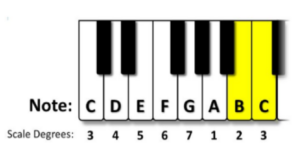The US Court of Appeals for the Ninth Circuit affirmed a district court’s order vacating a jury award of damages for copyright infringement and granting judgment as a matter of law, explaining that the musical work alleged to have been copied did not qualify as an original work of authorship but consisted only of “commonplace musical elements.” Marcus Gray PKA Flame et al. v. Katheryn Elizabeth Hudson PKA Katy Perry et al., Case No. 20-55401 (9th Cir. Mar. 10, 2022) (Clifton, Smith, Watford, JJ.)
Key Definitions:
-
A musical scale is a sequence of musical notes or tones by pitch.
-
A subset of seven notes is called the minor scale and can be referred to with alphabetic names (A, B, C, etc.) or scale degrees (1, 2, 3, etc.).
-
An ostinato is a repeating musical figure (for example, 3-3-3-3-2-2).

In 2007, Marcus Gray (Flame) purchased an ostinato and used it in the song “Joyful Noise.” The song was released in 2008. While “Joyful Noise” did not achieve significant commercial success or airtime, it received millions of views online. In 2013, American singer-songwriter Katy Perry created “Dark Horse,” which was a hit, resulting in her performance at the Super Bowl halftime show in 2015.
The “Joyful Noise” ostinato consists of notes, represented as 3-3-3-3-2-2-2-1 and 3-3-3-3-2-2-2-6, whereas Dark Horse’s ostinato contains 3-3-3-3-2-2-1-5. Both have a uniform rhythm and equal note duration in time.
Plaintiffs sued Perry and her co-defendants for copyright infringement. Plaintiffs presented circumstantial evidence that the defendants had a reasonable opportunity to access “Joyful Noise” and that the ostinatos in both songs were substantially similar. Plaintiffs did not present direct evidence that Perry and the others had copied elements of the song, instead relying on testimony from their expert musicologist, Dr. Todd Decker.
Decker testified that the ostinatos were similar in many aspects, but he also testified that there was no single element that caused him to believe the ostinatos at issue were “substantially similar” when viewed “in isolation.” The jury also heard testimony from Perry’s expert, who disagreed altogether that the ostinatos were substantially similar.
The jury found that the defendants had a reasonable opportunity to hear “Joyful Noise” before composing “Dark Horse,” that the two songs contained substantially similar copyrightable expression and that “Dark Horse” used protected material from “Joyful Noise.” The jury found the defendants liable for copyright infringement and awarded $2.8 million in damages. The district court vacated the award and granted judgment as a matter of law to defendants, concluding that the evidence at trial was legally insufficient to show that the “Joyful Noise” ostinato was a copyrightable original expression. The plaintiffs appealed.
The Ninth Circuit explained that because the plaintiffs did not present any direct evidence that the defendants copied the “Joyful Noise” ostinato, they were required to show that the defendants had access to the work and that the ostinatos were substantially similar.
The Ninth Circuit began with its analysis of the “substantially similar” prong, employing a two-part test having “extrinsic” and “intrinsic” components. The Court noted that while it must refrain from usurping the jury’s traditional role of evaluating witness credibility and weighing the evidence, the extrinsic test requires that the Court ensure that the evidence of objective similarities between two works is legally sufficient to serve as the basis of a copyright infringement claim, regardless of the jury’s views. The Court explained that the substantial similarity test focuses on the protectable elements standing alone and disregards non-protectable elements.
To be a protectable element under copyright law, the “Joyful Noise” ostinato had to qualify as “original expression.” Based on the trial record, the Ninth Circuit found that the “Joyful Noise” ostinato consisted entirely of commonplace musical elements, and that the similarities between the two ostinatos did not arise out of an original combination of these elements. Without original expression, no element identified by Flame was individually copyrightable. For example, the Court noted that “the fact that Joyful Noise and Dark Horse both make use of sequences of eight notes played in an even rhythm is a trite musical choice outside the protection of copyright law.”
Finding the evidence presented at trial legally insufficient to establish that the musical elements were individually copyrightable, the Ninth Circuit determined that the jury’s verdict finding defendants liable for copyright infringement was unsupported by substantial evidence. Thus, the Court affirmed the trial court’s grant of judgment as a matter of law.




 />i
/>i

